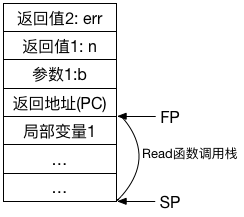不定参数&多返回值
不定参数只能是最后一个参数,它实际上是数组切片参数的语法糖:
// 语法糖 相当于 func myfunc(args []interface{})
func myfunc(args ...interface{}){
for _, arg := range args {
fmt.Println(arg)
}
// 参数会被打包为 []{arg1,arg2,arg3}
myfunc(arg1,arg2,arg3)
// 要完成可变参数的完美传递 需要用...将Slice打散
func myfunc2(args ...interface{})
// 此时args已经是Slice 如果不打散将作为一个参数 不能完美传递
myfunc(args)
// 编译器在此处有优化 最终会直接将args传入 不会打散再打包 参考: http://www.jianshu.com/p/94710d8ab691
myfunc(args...)
end
多返回值为函数提供了更大的便利性,无需传引用或者专门构造返回值结构体,并且在错误处理方面也更简便,在前面的示例代码中已经初尝甜头。
// 定义多返回值函数时,可以为返回值指定名字
func (file *File) Read(b []byte) (n int, err Error){
// n和err在函数开始时,被自动初始化为空
...
... n = xxx
...
... err = xxx
...
// 直接执行return时,将返回n和err变量的值
return
}
多返回值的在Plan9 C编译器上的实现是由调用者在其栈上分配n和err的内存,由被调用方修改调用方栈上的n和err的值:

匿名函数&闭包
匿名函数允许函数像变量一样被定义,传递,和使用。Go语言支持随时在代码里定义匿名函数。
// 赋给变量
F = func (a, b int) int {
return a + b
}
F(1,2)
// 直接执行
func (a, b int) int {
return a + b
}(1,2)
1. 闭包的概念
闭包是可以包含自由(未绑定到特定对象)变量的代码块,这些变量不在这个代码块内或者任何全局上下文中定义,而是在定义代码块的环境中定义。要执行的代码块(由于自由变量包含在代码块中,所以这些自由变量以及它们所引用的对象没有被释放)为自由变量提供绑定的计算环境(作用域)。
2. 闭包的价值
闭包的价值在于可以作为函数对象或者匿名函数,对于类型系统而言,这意味着不仅要表示数据还要表示代码。支持闭包的多数语言都将函数作为第一类对象,就是说这些函数可以存储到变量中作为参数传递给其它函数,最重要的是能够被函数动态创建和返回。
3. Go语言中的闭包
Go语言中的闭包同样也会引用到函数外的变量,闭包的实现确保只要闭包还被使用,那么闭包引用的变量会一直存在。
1 | package main |
为了实现闭包:
- Go必须有能力识别闭包函数的引用变量(这里的j),并将它们分配在堆上而不是栈上(escape analyze技术)
- 用一个闭包结构体保存函数和其引用环境
下面分别阐述这两点:
escape analyze
1 | package test |
在C语言中,在函数中返回该函数栈上的地址是不被允许的,因为当函数调用完成后函数栈会被回收。Go当然也有函数栈和栈回收的概念,因此它将i分配在堆上而不是栈上,通过go tool compile -S x.go查看汇编代码:
...
0x001d 00029 (tmp.go:3) LEAQ type.int(SB), AX
0x0024 00036 (tmp.go:3) MOVQ AX, (SP)
0x0028 00040 (tmp.go:3) PCDATA $0, $0
0x0028 00040 (tmp.go:3) CALL runtime.newobject(SB) // 相当于new(int)
0x002d 00045 (tmp.go:3) MOVQ 8(SP), AX // 将i的地址放入AX
0x0032 00050 (tmp.go:4) MOVQ $5, (AX) // 将AX存放的内存地址值设为5
...
也可通过-gcflags=-m选项编译来查看:
▶ go build --gcflags=-m x.go
./tmp.go:2: can inline F
./tmp.go:5: &i escapes to heap
./tmp.go:3: moved to heap: i
Go编译器依靠escape analyze来识别局部变量的作用范围,来决定变量分配在堆上还是栈上,这与GC技术是相辅相成的。
闭包结构体
闭包结构体在src/cmd/compile/internal/gc/closure.go的walkclosure函数生成,具体实现太过复杂,其注释简要地说明了实现方式:
// Create closure in the form of a composite literal.
// supposing the closure captures an int i and a string s
// and has one float64 argument and no results,
// the generated code looks like:
//
// clos = &struct{.F uintptr; i *int; s *string}{func.1, &i, &s}
//
// The use of the struct provides type information to the garbage
// collector so that it can walk the closure. We could use (in this case)
// [3]unsafe.Pointer instead, but that would leave the gc in the dark.
// The information appears in the binary in the form of type descriptors;
// the struct is unnamed so that closures in multiple packages with the
// same struct type can share the descriptor.
比如对我们闭包例子中return_closure生成的闭包,其闭包结构体表示为:
type.struct{
.F uintptr//闭包调用的函数指针
j *int// 指向闭包的上下文数据,c1,c2指向不同的堆地址
}
3. 错误处理
Go的错误处理主要依靠 panic,recover,defer,前两者相当于throw和catch,而defer则是Go又一个让人惊喜的特性,defer确保语句在函数结束(包括异常中断)前执行,更准备地说,defer语句的执行时机是在返回值赋值之后,函数返回之前:
1 | func f1() (r int) { |
因此,return x其实不是”原子操作”,在其中会插入defer函数执行,在Go官方文档中也提到了这点。
defer还有如下特性:
- 一个函数可定义多个defer语句
- 多个defer语句按照先入后出的顺序执行
- defer表达式中的变量值在defer表达式定义时就已经明确
- defer表达式可以修改函数中的命名返回值
defer的作用:
- 简化异常处理(在defetr中recover),避免异常与控制流程混合(try … catch … finally)
- 在defer中做环境清理和资源释放
更多阅读: